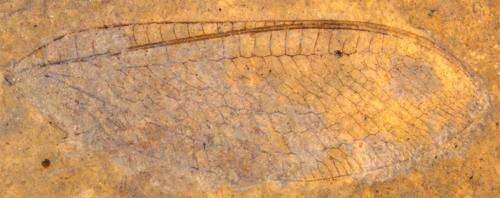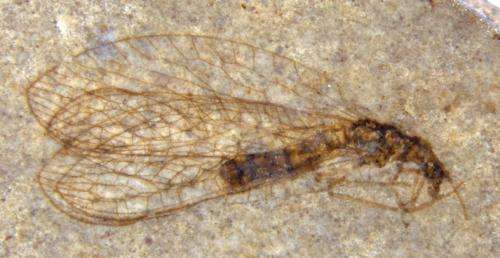Scientists discover distant relatives of gardeners' friend

(Phys.org) —In a new article published in the Journal of Paleontology, two paleontologists, including one from Simon Fraser University, describe the most diverse group of fossilized green lacewing insects known.
Green lacewings are familiar to gardeners, who value them in organic pest control, for their consumption of large numbers of aphids. The closest modern relatives to these insects are most diverse in southeastern Australia, the southwestern United States and northwestern Mexico.
SFU's Bruce Archibald and the Russian Academy of Sciences' Vladimir Makarkin named the first species of green lacewings from a series of 49- to 53-million-year-old fossil beds stretching across southern British Columbia into Washington State.
Makarkin and Archibald examined 24 fossils from the region, including some that they'd found and others belonging to regional museums, estimating that these contained at least 10 new species. Some of these fossils had minute details so finely preserved that six species could be given names.

Most of the new species are from the famed McAbee locality, near Cache Creek, B.C., which the provincial government recently named a heritage site. "This is a small sample of the treasures that this world-class locality has to offer," says Archibald.
Other fossils described by Archibald and Makarkin come from Driftwood Canyon Provincial Park in B.C.'s Bulkley Valley near Smithers, and from the United States in Republic, Washington State.
The scientists named one of the new species from Driftwood Canyon Provincial Park Pseudochrysopa harveyi in honour of the late area resident Gordon Harvey, recognizing his great generosity. He donated the fossil beds to B.C. Parks in 1967.
"The fossils from these localities have a lot left to tell us, not only as a window into ancient life of the deep past, but also about how our modern natural communities were formed," says Archibald. "So, stay tuned."
More information: The scientists' paper, A diverse new assemblage of green lacewings (Insecta, Neuroptera, Chrysopidae) from the early Eocene Okanagan Highlands, western North America, can be downloaded free from: brucearchibald.com/
Journal information: Journal of Paleontology
Provided by Simon Fraser University




















